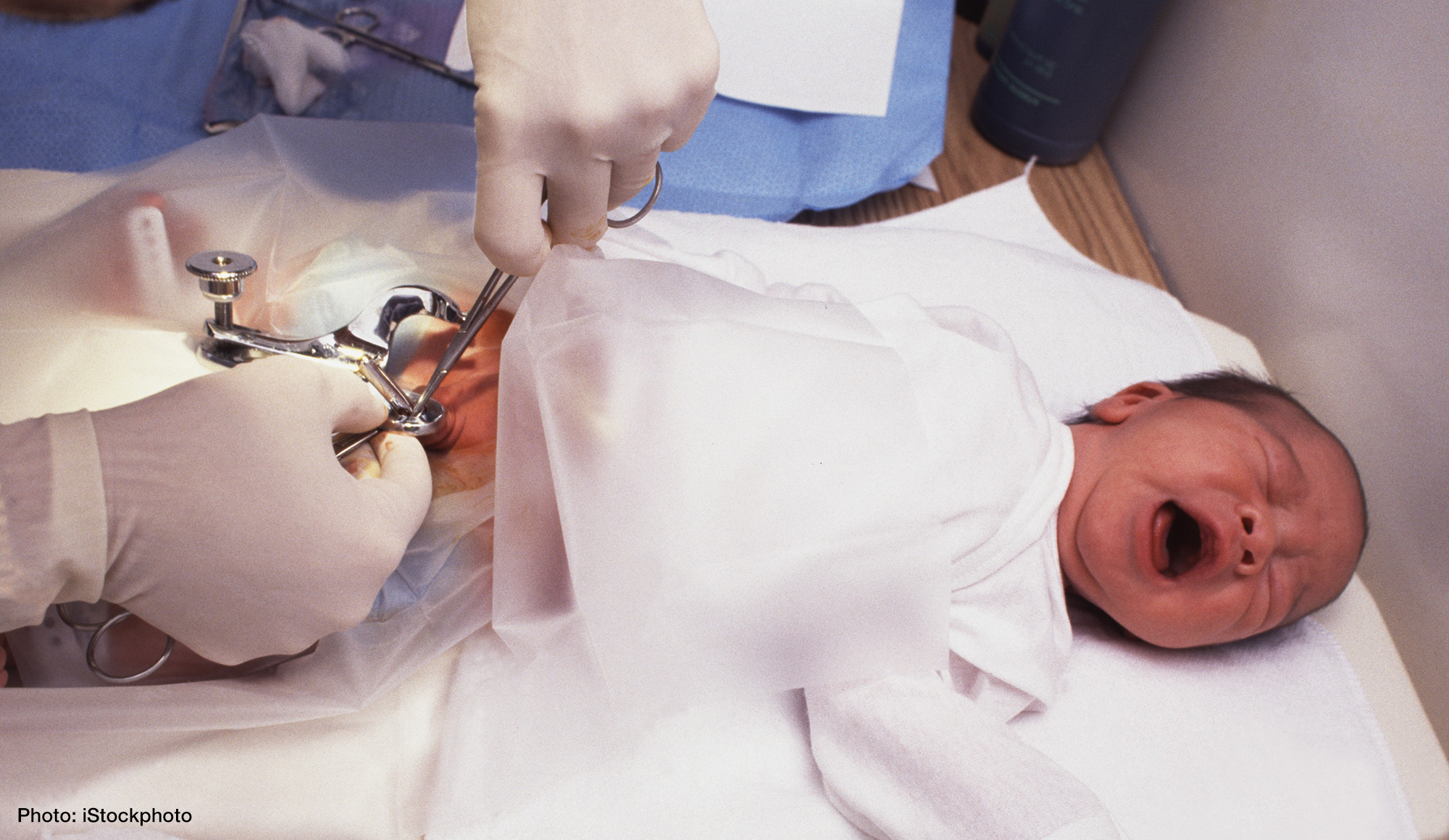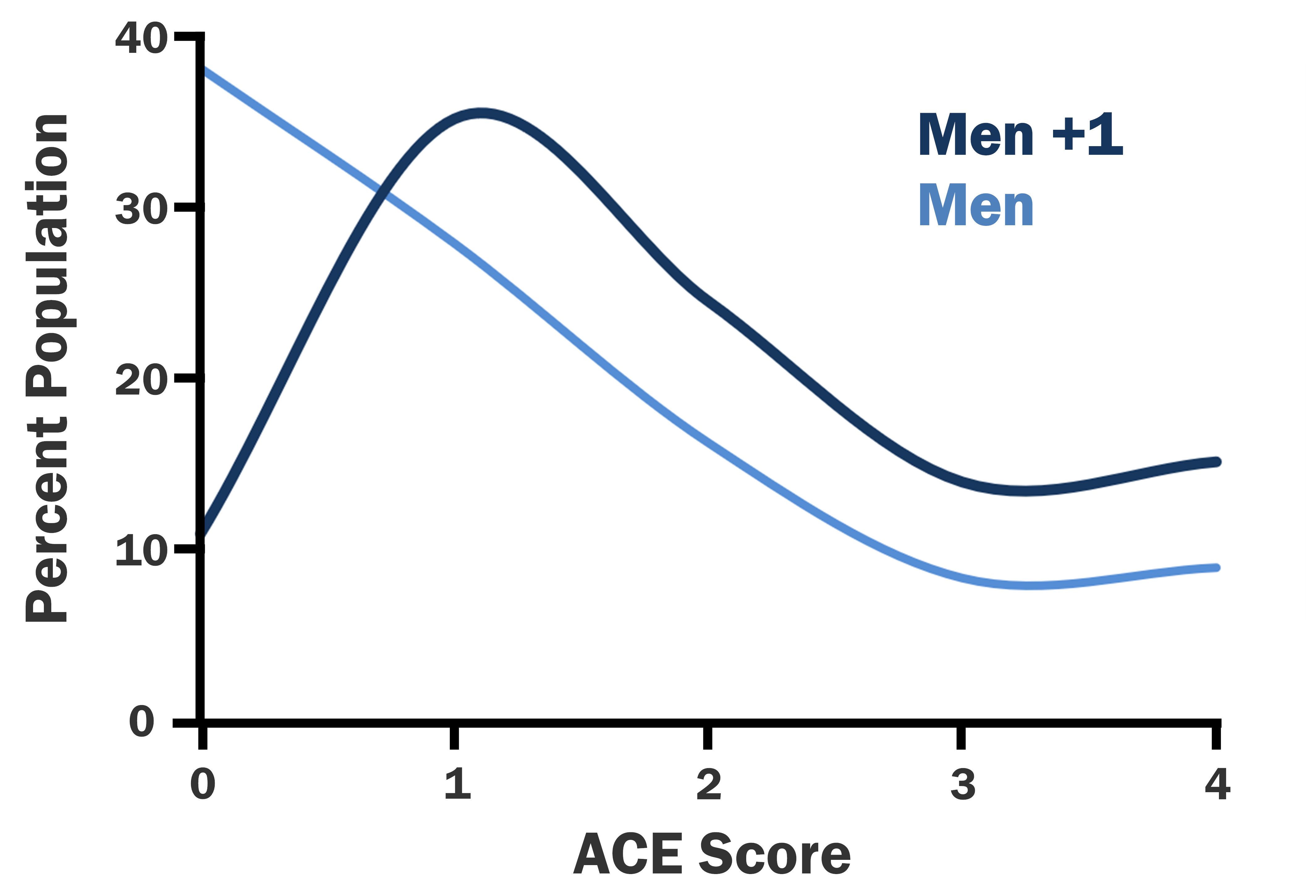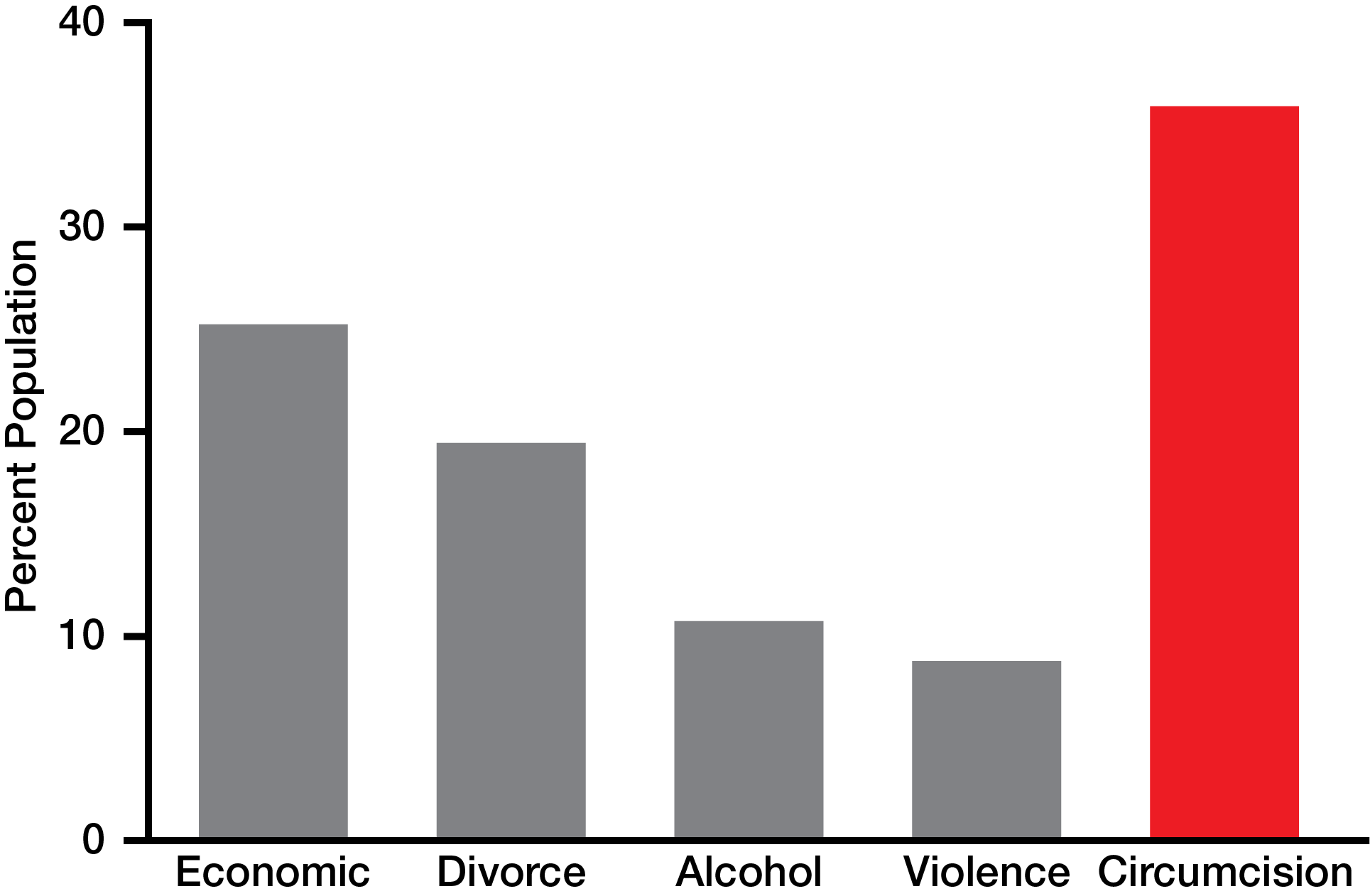About This Quiz
Involuntary childhood genital cutting—including female genital mutilation, gender-norming surgery of intersex children, and male circumcision—is painful and traumatic and has been found to permanently alter individuals' sexuality, and to have other lifelong consequences. These early traumas are not included on the ACE checklist.
In this adaptation (which we hope will be incorporated in all ACE checklists in the future), question number three is expanded by adding this line incorporating a common childhood adverse sexual experience:
...or
Surgically alter your genitals or
circumcise you at birth or later?
Other ACE surveys have also been expanded to include traumas, including race and gender discrimination, witnessing a sibling being abused, witnessing violence outside the home, witnessing a father being abused by a mother, being bullied by a peer or adult, involvement with the foster care system, living in a war zone, living in an unsafe neighborhood, and losing a family member to deportation.
It is reasonable to conclude that involuntary genital cutting meets the criteria of a major Adverse Childhood Experience and therefore belongs on all ACEs checklists.
The following substantiation for this proposed addition is taken from the white paper Childhood Genital Cutting as an ACE by Dan Bollinger and Georganne Chapin.
Does involuntary genital cutting meet the criteria for an Adverse Childhood Experience?
Given the pervasiveness of newborn male circumcision in the United States, the hidden horror of female genital mutilation, and the growing body of information regarding lasting harms of gender-norming surgery among intersex persons, one might ask why there has not been more examination of these practices' impact.
In adults, abnormal and painful neonatal experiences can manifest in a host of changed adult behaviors that include increased anxiety, altered pain sensitivity, stress disorders, hyperactivity, and attention deficit disorder, leading to impaired social skills and patterns of self-destructive behavior1 —hallmarks of high ACE scores.
Non-explicit adverse experiences
A new ACE-related study concluded that harmful non-explicit adverse experiences (those not listed on the current ACE questionnaire) also put children at risk for early development,2 highlighting that they may be just as important to identify.
In Nadine Burke Harris' book3 on toxic stress and the accumulation of ACEs, the author observed: "The fact that our patients with four or more ACEs were 32.6 times as likely to have been diagnosed with learning and behavioral problems signaled to us that ACEs had an outsize effect on children's rapidly developing brains."
Should newborn male genital cutting be added to the list of traumas for assessing individuals' risk for health and social problems?
Regarding newborn male genital cutting (a.k.a. circumcision), its very ubiquity is what likely inhibits an open discussion about the practice. While its incidence has fallen somewhat over the past two decades, still more than half of all boys born in the U.S. each year are subjected to it. Perhaps even more astonishing is that an estimated 75 million American men are living with surgically altered genitals.
 Typical hospital circumcision of a newborn boy
The weaker sex
A recent study on HIV risk behaviors found that just one or more ACEs significantly increased males' engagement in high risk behavior, whereas, for women, three or more ACEs were required to correspondingly increase their engagement in high risk behavior.4 Notably, boys' brains mature more slowly than girls' brains, making them more vulnerable to early stressors, for a longer period of time.5 Hence, despite popular opinion, it seems that boys, not girls, may be "the weaker sex"6 in that they are more vulnerable than girls to ACEs.7
Further evidence suggests that the adverse consequences of high ACE exposure don't wait until adulthood to manifest; rather they show up in children as physical, mental and developmental problems.8
A literature review of more than a hundred psychological studies shows that early traumas have a detrimental effect on a boy's psyche, and about half of those mention circumcision specifically.9
Recollection
Whether a child consciously remembers an experience is irrelevant to its impact and therefore its status as an ACE. Some of the questions in the ACE questionnaire assume having historical knowledge of events from birth onward, such as: "Were your parents ever separated or divorced?" Early childhood is a time for significant brain development, and unrecallable or forgotten trauma is still trauma. It is not the recollection of a trauma that is harmful, rather the body's and mind's response to it, both immediately and over time.
Consequences
Newborn male genital cutting (a.k.a.circumcision) and ACEs are very closely associated with alexithymia—the inability to identify and express emotions.10 11 12 Like ACEs, genital cutting has been associated with addiction and suicide,13 and victims of childhood sexual abuse are more than twice as likely to attempt suicide.14 Recently, a preliminary study by Danish researchers has linked circumcision trauma to autism,15 painting a frightening prospect if this association is subsequently substantiated. Adding sexual insult to sexual injury, male genital cutting is also associated with erectile dysfunction.16
What are the implications for adding child genital cutting to the ACE inventory?
The ACE self-report questionnaire is surprisingly simple to implement, which is one reason for its rapid and widespread uptake. Participants are asked to check the box next to a list of ten possible childhood experiences and then tally the number of check marks to obtain their ACE score. By now, the reader has probably taken this quiz and knows their ACE score.
It should be noted that the ACE questionnaire does not represent the entire spectrum of early adversities that exist, nor does it measure critical dimensions of exposure, such as severity or the age at onset—both which can significantly affect health and well-being. Rather, it is intended as a preliminary screening tool to quickly identify at-risk individuals and groups who should be beneficiaries of interventions such as social programs and resilience training. As the field of risk assessment evolves, researchers and practitioners are gaining understanding that experiences heretofore not explicitly recognized may be powerful predictors of adult behavior, and are adding additional related questions to their ACES interview instruments.
Typical hospital circumcision of a newborn boy
The weaker sex
A recent study on HIV risk behaviors found that just one or more ACEs significantly increased males' engagement in high risk behavior, whereas, for women, three or more ACEs were required to correspondingly increase their engagement in high risk behavior.4 Notably, boys' brains mature more slowly than girls' brains, making them more vulnerable to early stressors, for a longer period of time.5 Hence, despite popular opinion, it seems that boys, not girls, may be "the weaker sex"6 in that they are more vulnerable than girls to ACEs.7
Further evidence suggests that the adverse consequences of high ACE exposure don't wait until adulthood to manifest; rather they show up in children as physical, mental and developmental problems.8
A literature review of more than a hundred psychological studies shows that early traumas have a detrimental effect on a boy's psyche, and about half of those mention circumcision specifically.9
Recollection
Whether a child consciously remembers an experience is irrelevant to its impact and therefore its status as an ACE. Some of the questions in the ACE questionnaire assume having historical knowledge of events from birth onward, such as: "Were your parents ever separated or divorced?" Early childhood is a time for significant brain development, and unrecallable or forgotten trauma is still trauma. It is not the recollection of a trauma that is harmful, rather the body's and mind's response to it, both immediately and over time.
Consequences
Newborn male genital cutting (a.k.a.circumcision) and ACEs are very closely associated with alexithymia—the inability to identify and express emotions.10 11 12 Like ACEs, genital cutting has been associated with addiction and suicide,13 and victims of childhood sexual abuse are more than twice as likely to attempt suicide.14 Recently, a preliminary study by Danish researchers has linked circumcision trauma to autism,15 painting a frightening prospect if this association is subsequently substantiated. Adding sexual insult to sexual injury, male genital cutting is also associated with erectile dysfunction.16
What are the implications for adding child genital cutting to the ACE inventory?
The ACE self-report questionnaire is surprisingly simple to implement, which is one reason for its rapid and widespread uptake. Participants are asked to check the box next to a list of ten possible childhood experiences and then tally the number of check marks to obtain their ACE score. By now, the reader has probably taken this quiz and knows their ACE score.
It should be noted that the ACE questionnaire does not represent the entire spectrum of early adversities that exist, nor does it measure critical dimensions of exposure, such as severity or the age at onset—both which can significantly affect health and well-being. Rather, it is intended as a preliminary screening tool to quickly identify at-risk individuals and groups who should be beneficiaries of interventions such as social programs and resilience training. As the field of risk assessment evolves, researchers and practitioners are gaining understanding that experiences heretofore not explicitly recognized may be powerful predictors of adult behavior, and are adding additional related questions to their ACES interview instruments.
 Effect of men's ACE scores distribution after adding
one to the ACE scores of men in the United States who are circumcised.
We know that 17.8 percent of men have ACE scores of 3, 4, and 5. An ACE score above six is associated with a 30-fold increase in suicide attempts and a lifespan shortened by almost 20 years.17
About 75 percent of United States men over the age of 18 are circumcised.18 Adding an additional ACE to the other ACEs that these men might have experienced exposes what can only be described as a national health crisis.
Accounting for sexual abuse
One in six men reported having experienced childhood sexual abuse. When newborn genital cutting is factored in for the 75 percent of men who had not reported a childhood sexual abuse in that study, the childhood sexual abuse ratio rises to four out of five men.
Effect of men's ACE scores distribution after adding
one to the ACE scores of men in the United States who are circumcised.
We know that 17.8 percent of men have ACE scores of 3, 4, and 5. An ACE score above six is associated with a 30-fold increase in suicide attempts and a lifespan shortened by almost 20 years.17
About 75 percent of United States men over the age of 18 are circumcised.18 Adding an additional ACE to the other ACEs that these men might have experienced exposes what can only be described as a national health crisis.
Accounting for sexual abuse
One in six men reported having experienced childhood sexual abuse. When newborn genital cutting is factored in for the 75 percent of men who had not reported a childhood sexual abuse in that study, the childhood sexual abuse ratio rises to four out of five men.
 Percent of adults reporting childhood sexual abuse
and after newborn circumcision is accounted for.
Conclusion
Comparing male genital cutting to the most commonly experienced ACEs already included in the ACE questionnaire (economic hardship, parental divorce, living with anyone who had an alcohol problem, or witnessing violence)19 reveals it as a significant childhood stressor, which is sufficient reason to include genital cutting in the ACE questionnaire.
Percent of adults reporting childhood sexual abuse
and after newborn circumcision is accounted for.
Conclusion
Comparing male genital cutting to the most commonly experienced ACEs already included in the ACE questionnaire (economic hardship, parental divorce, living with anyone who had an alcohol problem, or witnessing violence)19 reveals it as a significant childhood stressor, which is sufficient reason to include genital cutting in the ACE questionnaire.
 Prevalence of the four most common ACEs compared to
the proportion of circumcised men in the US adult population.
Given the foregoing, it is reasonable to conclude that involuntary childhood genital cutting (including newborn male circumcision) meets the criteria of a major Adverse Childhood Experience and therefore belongs on the official ACEs checklist.
References
Prevalence of the four most common ACEs compared to
the proportion of circumcised men in the US adult population.
Given the foregoing, it is reasonable to conclude that involuntary childhood genital cutting (including newborn male circumcision) meets the criteria of a major Adverse Childhood Experience and therefore belongs on the official ACEs checklist.
References
[
1 Anand KJ, Scalzo FM. Can adverse neonatal experiences alter brain development and subsequent behavior? Biol Neonate. 2000;77(2):69-82. ]
2 McKelvey LM, Conners Edge NA, Fitzgerald S, Kraleti S, Whiteside-Mansell L. Adverse childhood experiences: Screening and health in children from birth to age 5. Families, Systems, & Health. 2017:35(4);420-429.
3 Harris NB. "The deepest well: Healing the long-term effects of childhood adversity." New York: Houghton Mifflin Harcourt Publishing Company, 2018. p58.
4 Fang L, Chuang DM, Lee Y. Adverse childhood experiences, gender, and HIV risk behaviors: Results from a population-based sample. Prev Med Rep. 2016;4:113-20.
5 Shore AN. All our sons: The developmental neurobiology and neuroendocrinology of boys at risk. Inf Mental Health J, 2017;38(1):15-52.
6 Kraemer S. The fragile male. BMJ. 2000;321:1609-12.
7 Narvaez D. Be worried about boys, especially baby boys.
8 Bright MA, Knapp C, Hinojosa MS, Alford S, Bonner B. The comorbidity of physical, mental, and developmental conditions associated with childhood adversity: A population based study. Maternal and Child Health Journal. 2016;20(4):843-853.
9 Bollinger D. Normal versus cut: Final psychological score, 100-0.
10 Bollinger D, Van Howe RS. Alexithymia and circumcision trauma: A preliminary investigation. Int J Men's Health. 2011;10(2):184-95.
11 Bermond B, Moormann PP, Albach F, van Dijke A. Impact of severe childhood sexual abuse on the development of alexithymia in adulthood. Psychother Psychosom. 2008;77:260-2.
12 Hahn AM, Simons RM, Simons JS. Childhood maltreatment and sexual risk taking: The mediating role of alexithymia. Arch Sex Behav. 2016;45(1):53-62.
13 Boyle GJ, Goldman R, Svoboda JS, Fernandez E. Male circumcision: Pain, trauma and psychosexual sequelae. J Health Psychology. 2002;7(3):329-43.
14 Dube SR, Anda RF, Whitfield CL, Brown DW, Felitti VJ, Dong M, Giles WH. Long-term consequences of childhood sexual abuse by gender of victim. Am J Prev Med. 2005;28(5):430-8.
15 Frisch M, Simonsen J. Ritual circumcision and risk of autism spectrum disorder in 0- to 9-year-old boys: National cohort study in Denmark. J R Soc Med. 2015;108(7):266-79.
16 Bollinger D. Adding insult to injury: Acquisition of erectile dysfunction from circumcision. 2011.
17 CDC Infographics.
18 World Health Organization. Male circumcision: Global trends and determinants of prevalence, safety and acceptability. 2007.
19 Sacks V, Murphey D, Moore K. Adverse childhood experiences: National and state level prevalence. Child Trends. 2014-28. Table 2.
The iOs and Android apps and this site were created by Dan Bollinger, developed by Hudson Center for Health Equity and Quality, a(501(c)(3) corporation, for Intact America.
Copyright 2019 HCHEQ All Rights Reserved



